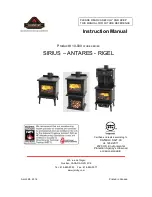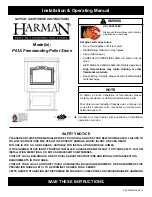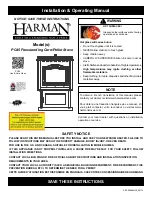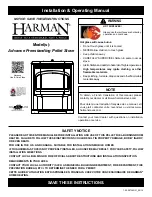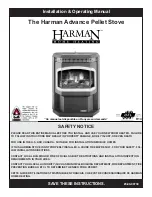
Hearthstone
Quality Home Heating Products, Inc.
® Heritage Model 8021
Page 21 of 30
Build and maintain your first fire and first fire each
season thereafter as outlined above. Your patience
will be rewarded by a properly seasoned stove.
NOTE:
Cool flue gas temperatures present
during the break-in procedure may cause rapid
creosote build-up. The glass may also get dirty.
A good hot fire will clean it. We recommend a
visual inspection (and cleaning if necessary) of
your stovepipe and chimney once the break-in
procedure is completed.
N
ORMAL
O
PERATION
If your stove is not used continuously or has not
been used in quite some time, follow the break-in
procedure at least once to minimize the stress of a
hot fire on a cold stove before proceeding with
normal operation. We recommend one break-in fire
at the start of each heating season.
Prior to loading the stove, ensure the ash grate,
refractory soapstone, and the ash pan are in place.
Ensure the ash door is closed to prevent over-firing.
Also, ensure you clear away the ashes around the
“doghouse.” The doghouse is the slight bulge of
metal, located in the front lower center of the firebox.
If the front door is open, the doghouse is in the lower
center of the door opening. There is a hole located
on the opposite side, which directs primary air into
the coal bed area of the firebox. Obstructing this
hole will hinder the operation of the stove. Along with
the glass’ air wash, the air flow is regulated via the
primary air control lever.
Building A Fire For Everyday Use
1. Open the front or side door and place five or six
double sheets of tightly twisted newspaper in the
center of the firebox. Arrange kindling in a
crisscross pattern over the newspaper. Kindling
should be approximately ten pieces, 1/2" (13
mm) in diameter and 10" to 18" (254 to 457 mm)
long.
2. Fully open the primary air control by pushing it
completely to the left, away from the firebox.
3. Light the paper under the kindling. Leave the
front door slightly ajar momentarily until the
kindling has started to burn and draft begins to
pull.
4. Close the door and allow the fire to burn.
5. Once the kindling is burning, open the front or
side door and add logs, small at first, to build the
fire up. Make sure to keep the logs away from
the glass in front in order for the air-wash
system to work properly. Keep the front door
and ash door closed while the stove is in use.
6. Once the fire is burning well, use the primary air
control to regulate the desired rate of burn.
Pushing the handle to the left opens the
PRIMARY AIR CONTROL for a high rate of burn
or pushing it to the right for a low rate of burn.
NOTE:
When opening the front or side door
to reload or re-arrange logs, it is advisable to
open the door just a crack, pause for a
moment then open the door completely. This
procedure will allow the firebox to clear of
smoke before the door is opened fully. Also,
reloading on a bed of hot, red coals reduces
smoking time and will bring fresh fuel up to a
high temperature rapidly.
Burn Rate
HIGH BURN:
Fully load the firebox with wood on a
bed of hot coals or on an actively flaming fire and
fully open the primary air control by moving it fully to
the left, away from the firebox. This will fully open
the primary air shutter. A high burn rate is
recommended once or twice a day to fully heat the
stovepipe and chimney, which will help minimize
creosote accumulation. Sustained top, center stone
temperature should not exceed 600° Fahrenheit
(316
C).
MEDIUM HIGH BURN:
With the primary air control
in the closed position, move the control handle
slightly to the left.
MEDIUM LOW BURN:
With the primary air control
in the closed position, move the handle half way
between the medium and low settings. A medium-
low burn rate should be the typical setting and is
preferable if the stove is to be left unattended.
LOW BURN:
Close the primary air control by
moving it fully to the right. A low burn rate over
extended periods of time is not advisable as it may
promote the accumulation of creosote. Inspect the
venting system frequently if low burn rates are
maintained consistently.
NOTE:
If equipped with the optional blower, the
following settings are recommended:
Low and Medium-Low Burn: Run the blower on low
for slower moving, but warmer air circulation. Turn
the knob ‘ON’, and then continue turning the control
knob clockwise until the blower is running at a low
speed.
Medium High and High Burn: Run the blower on
high for maximum circulation. The blower speed is at
its highest setting when the control knob is first

























